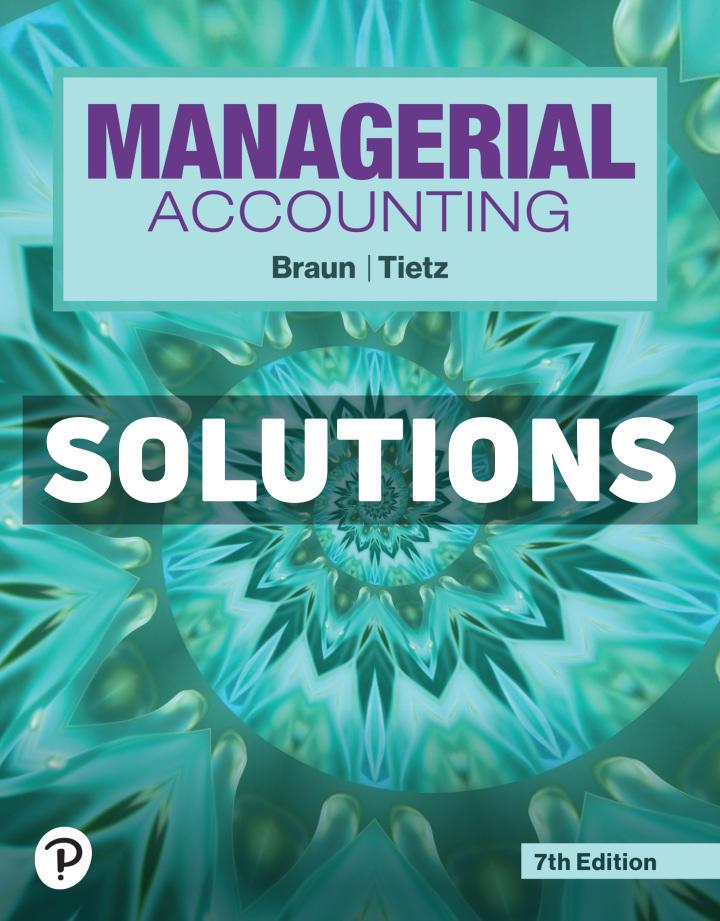

Chapter 1
Introduction to Managerial Accounting
Quick Check
Answers
QC1-1. c
QC1-2. d
QC1-3. b
Short Exercises
QC1-4. d
QC1-5. d
QC1-6. c
QC1-7. a
QC1-8. c
QC1-9. b
QC1-10. a
QC1-11. d
QC1-12. b
(5–10 min.) S1-1
a. Planning
b. Controlling
c. Directing
d. Directing
e. Directing, Controlling (5–10 min.) S1-2
a. Financial accounting
b. Financial accounting
c. Financial accounting
d. Managerial accounting
e. Managerial accounting
f. Managerial accounting
g. Financial accounting
h. Financial accounting
i. Managerial accounting
j. Managerial accounting
k. Financial accounting
l. Managerial accounting
m. Financial accounting
a. Internal Auditing Department
b. Controller
c. Internal Auditing Department
d. Internal Auditing Department
e. Treasurer
f. Controller
g. Controller
h. Controller
i. Controller
j. Controller
k. Controller
l. Treasurer
m. Treasurer
Characteristic
a. Reports directly to the audit committee
b. Reports to treasurer or controller
c. Is part of the Accounting Department
d. Helps to ensure that company’s internal controls are functioning properly
e. Performs the same function as independent certified public accountants
f. Usually reports to a senior executive (CFO or CEO) for administrative matters
g. External audits can be performed by the internal auditing department
h. Required by the New York Stock Exchange if company stock is publicly traded on the NYSE
i. Ensures that the company achieves its profit goals
Check (√) if related to internal auditing
(10 min.) S1-5
a. The CEO is hired by the board of directors.
b. A subcommittee of the board of directors is called the audit committee.
c. Raising capital and investing funds are the direct responsibilities of the treasurer.
d. The CFO and the COO report to the CEO.
e. Financial accounting, managerial accounting, and tax reporting are the direct responsibilities of the controller.
f. Management accountants often work on cross-functional teams.
g. The internal audit function reports to the CFO or the CEO and the audit committee.
h. The company’s operations are the direct responsibility of the COO. (5 min.) S1-6
1. The Institute of Management Accountants (IMA) issues the Certified Management Accountant (CMA) certification.
2. The certification offered by IMA, focuses on accounting and finance topics.
3. The monthly professional magazine published by the Institute of Management Accountants is called Strategic Finance
4. The certification launched in 2012 jointly by the Association of International Certified Professional Accountants (AICPA) and the Chartered Institute of Management Accountants (CIMA) is called the Chartered Global Management Accountant (CGMA).
5. To earn CMA certification, a candidate must have a(n) baccalaureate degree. The CMA exam can be taken, however, before finishing this degree.
(5 min.) S1-7
a. Failing to provide job description information to management because you fear it may be used to cut a position in your department violates the credibility standard.
b. Providing earnings information to your sister before it is publicly announced violates the confidentiality standard.
c. Failing to read the specifications of the software package before purchasing it violates the competence standard
d. Stealing from your employer is a violation of the integrity standard.
e. Skipping continuing education sessions could violate the requirement to maintain professional competence. If your company paid for you to attend the conference, skipping the sessions also violates the integrity standard.
(5 min.) S1-8
a. Sustainability
b. Sarbanes-Oxley Act (SOX)
c. Enterprise resource planning (ERP) system
d. Data analytics
Letter Scenario
a. Aidan, an accountant for a smartphone manufacturer, told his friends about a new model of smartphone being released by the company in the following quarter. For competitive reasons, the company keeps its models shrouded in secrecy until release date.
b. The CFO directed that certain expenses be reclassified as assets, so that target profit could be achieved. The CFO rationalized that jobs would be saved by reaching the targeted income figures.
c. Even though Meagan's company is adopting a new ERP system that impacts the accounting system, Meagan (a management accountant) has not completed the required ERP training from the vendor.
d. Mateo provides an analysis of the profitability of a company-owned store that is managed by Mateo’s best friend, Akeno. Mateo neglects to include allocated fixed costs in Akeno’s report. If Mateo includes those allocated fixed costs, the store will show a loss and Akeno’s job could be in danger.
e. Yimeng, a purchasing agent for their company, received two tickets from a supplier to the upcoming Ohio State versus University of Michigan football game. These tickets sell for over $500 each.
a. Financial accounting system
b. Critical thinking
c. IMA
d. Treasurer
e. Economic, environmental, and social
f. Controller
g. Internal audit
h. Sarbanes-Oxley Act of 2002
i. Triple Bottom Line
j. Controlling
k. Directing
l. ERP
m. Sustainability
n. CEO
o. Planning
p. CFO
(5 min.) S1-9
Standard violated
Confidentiality
Integrity
Competence
Credibility
Integrity
(10 min.) S1-10
Chapter 1 Introduction to Managerial Accounting
Copyright © 2024 Pearson Education, Inc. (5 min.) S1-11
Data analytics adds more fact-based information to the decision-making process. Data analytics allows organizations to make quicker decisions. Data analytics can also increase the efficiency of internal operations. Data analytics can help companies better adapt and respond to customer’s individual preferences by more specifically tailoring marketing efforts. Finally, data analytics can drive company innovation and have a disruptive effect on existing industries.
Format as accounting number
Insert new workbook
Insert function
Worksheet name
Decrease decimal
Active cell
Ribbon
Name of workbook (file name)
Cell reference
(10 min.) S1-13
Task Description of how to do the task in Excel (Windows)
1. Change the order of the worksheets in the workbook
2. Copy and paste the contents of one cell to another cell
c. Drag and drop worksheet to desired location.
j. In the first cell, hold down Ctrl + C, then navigate to the desired cell and hold down Ctrl + V.
3. Copy the contents of a cell to a range of cell a. Drag the fill handle down the column or across the row.
4. Go to the end of the data set in a worksheet g. Hold down the Ctrl and End keys simultaneously.
5. Move between worksheets
6. Refer to a cell as an absolute reference
7. Rename worksheet
8. Select a range of cells
9. Select all data in a worksheet
i. Click on a worksheet tab.
d. Put dollar signs in front of both the column and row reference in the formula.
h. Right click worksheet tab and select option to give the worksheet a new name.
b. Click on the first cell in a range and drag your cursor to the final cell you are selecting.
e. Hold down the Ctrl and A keys simultaneously.
10. Select one cell f. Click on a cell.
a. =B2*C2
b. Drag the cell handle in the lower right corner of Cell D2 down to Cell D5.
c. =SUM(B2:B5)
d. =SUM(D2:D5)
e. =B2+B4
f. =D2+D4
g. =B10/B9
h. =B3-B5
i. =D3-D5
a. To quickly navigate to the end of the data in a worksheet when using Excel in a Windows environment, use the Ctrl + End keystrokes.
b. The top bar in an Excel workbook that contains File, Home, Insert, and other tabs is called the ribbon.
c. File, Home, Insert, Page Layout, Formulas, and Data are examples of tabs
d. The formula bar displays how the content of the active cell was generated.
e. To select all data in a worksheet when using Excel in a Windows environment, use the Ctrl + A keystrokes.
f. The worksheet tab is right clicked to rename it.
g. The active cell will have a colored border around it and the cell reference will appear in the name box.
h. A unique address for each cell in an Excel worksheet is called a cell reference
i. The cell reference for the active cell will appear in the name box.
j. To quickly navigate to the first column of a row in Excel when using Excel in a Windows environment, use the Ctrl + arrow left keystrokes.
k. There are separate tabs for each worksheet in a workbook.
Exercises (Group A)
(10 min.) E1-16A
a. Information on a company’s past performance is provided to external parties by financial accounting
b. Managerial accounting systems are chosen by comparing the costs versus the benefits of the system and are not restricted by GAAP (or International Financial Reporting Standards, IFRS, in the case of companies headquartered in many countries outside of the United States).
c. Managerial accounting systems report on various segments or business units of the company.
d. Financial accounting develops reports for external parties such as creditors and shareholders.
e. When managers evaluate the company’s performance compared to the plan, they are performing the controlling role of management.
f. CPAs audit the financial accounting statements of public companies.
g. Companies must follow GAAP (or International Financial Reporting Standards, IFRS, in the case of companies headquartered in many countries outside of the Unites States) in their financial accounting systems.
h. Choosing goals and the means to achieve them is the planning function of management.
i. Decision makers inside a company are the managers (10 min.) E1-17A
a. Technical
b. Nontechnical
c. Technical
d. Nontechnical
e. Nontechnical
f. Nontechnical
g. Technical
h. Technical
i. Technical
j. Technical
k. Nontechnical
l. Nontechnical
m. Technical
n. Nontechnical
o. Technical
p. Technical
q. Nontechnical
r. Nontechnical
s. Technical
t. Nontechnical
a. Economic
b. Social
c. Environmental
d. Social
e. Environmental
f. Social
g. Economic
h. Environmental
i. Environmental
j. Social
k. Social
l. Social
m. Social
n. Environmental
Excel file should show:
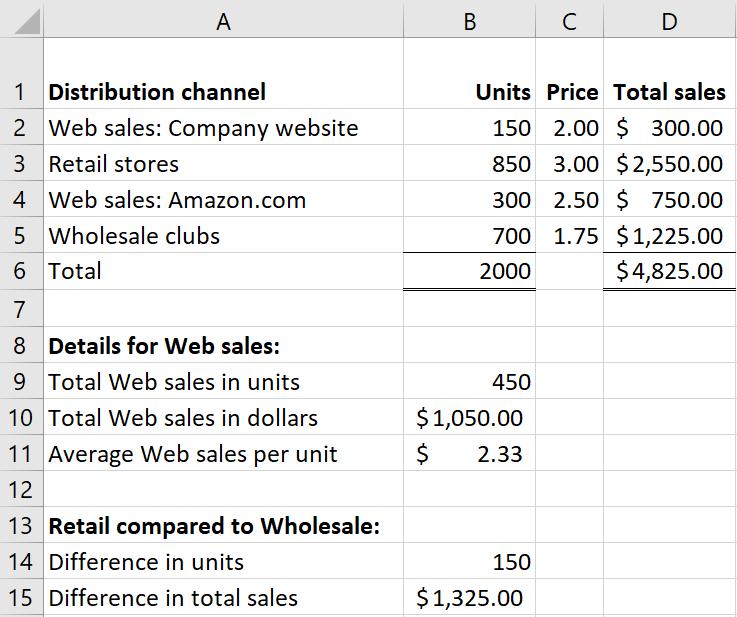
Formulas in each cell should be:
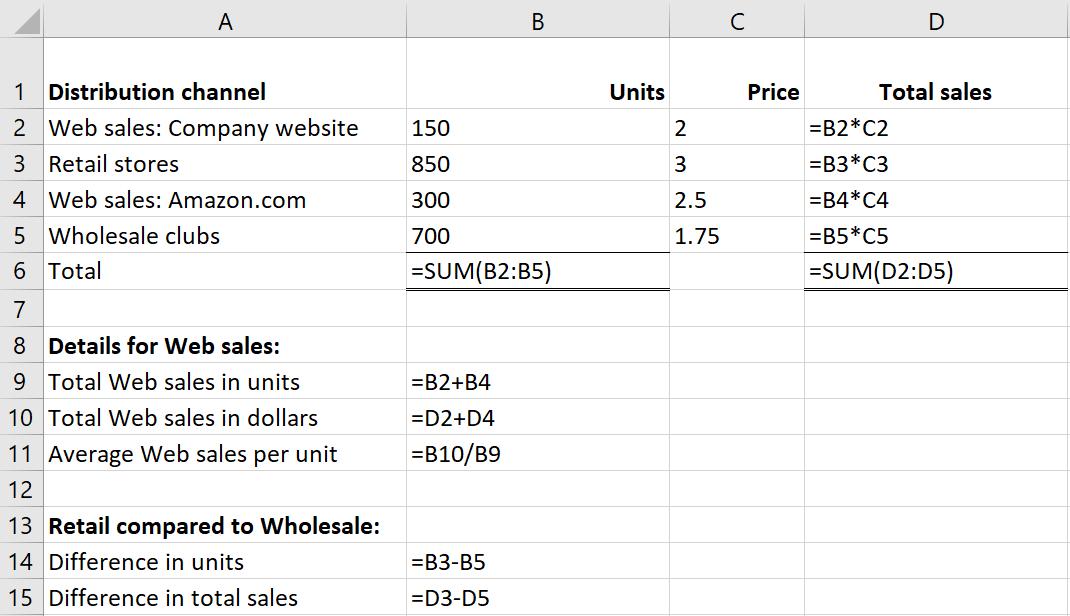
1. 985
2. MD-Disability
3. 389
4. 3
5. 49926
6. See below
a. $636.10 b. 12
c. $7,633.20
7. 80840
8. Click in the cell in the upper left corner of the worksheet (the intersection of the row and column headers)
Excel file should show:

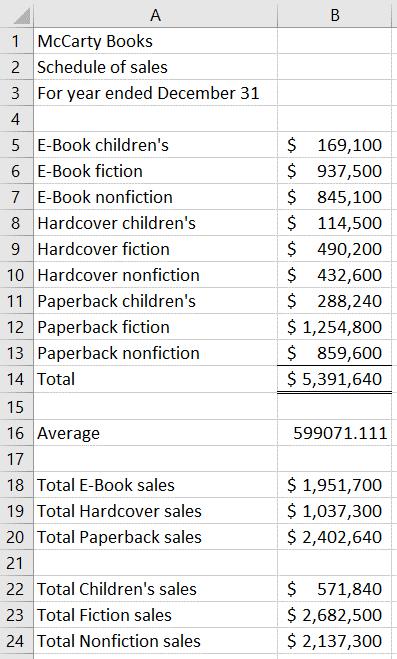
Formulas in each cell should be:
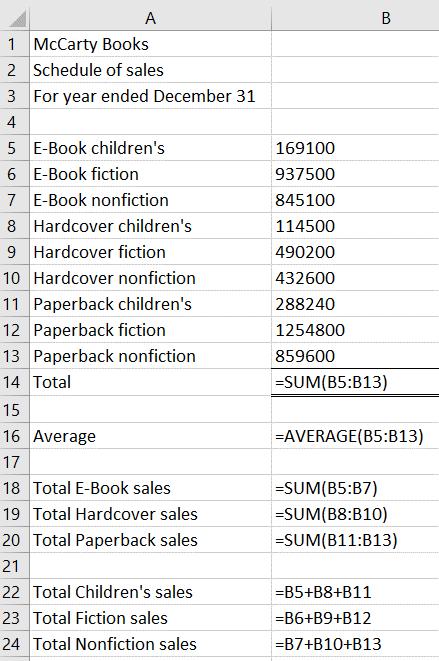

Exercises (Group B)
(5 min.) E1-25B
a. U.S. companies must follow GAAP (or International Financial Reporting Standards, IFRS, in the case of companies headquartered in many countries outside of the United States) in their financial accounting systems.
b. Financial accounting develops reports for external parties, such as creditors and shareholders.
c. When managers evaluate the company’s performance compared to the plan, they are performing the controlling role of management.
d. Managers are decision makers inside a company.
e. Financial accounting provides information on a company’s past performance to external parties.
f. Managerial accounting systems are not restricted by GAAP (or International Financial Reporting Standards, IFRS, in the case of companies headquartered in many countries outside of the United States) but are chosen by comparing the costs versus the benefits of the system.
g. Choosing goals and the means to achieve them is the planning function of management.
h. Managerial accounting systems report on various segments or business units of the company.
i. Financial accounting statements of public companies are audited annually by CPAs.
a. Nontechnical
b. Nontechnical
c. Nontechnical
d. Technical
e. Nontechnical
f. Technical
g. Technical
h. Technical
i. Nontechnical
j. Technical
k. Nontechnical
l. Technical
m. Nontechnical
n. Technical
o. Technical
p. Technical
q. Technical
r. Nontechnical
s. Nontechnical
t. Nontechnical
Wages (25 workers x 50 hrs. x $15/hr.) $18,750
x 7.65%)
a. Social
b. Environmental
c. Environmental
d. Economic
e. Environmental
f. Social
g. Environmental
h. Social
i. Environmental
j. Social
k. Economic
l. Social
m. Environmental
n. Social
Excel file should show:
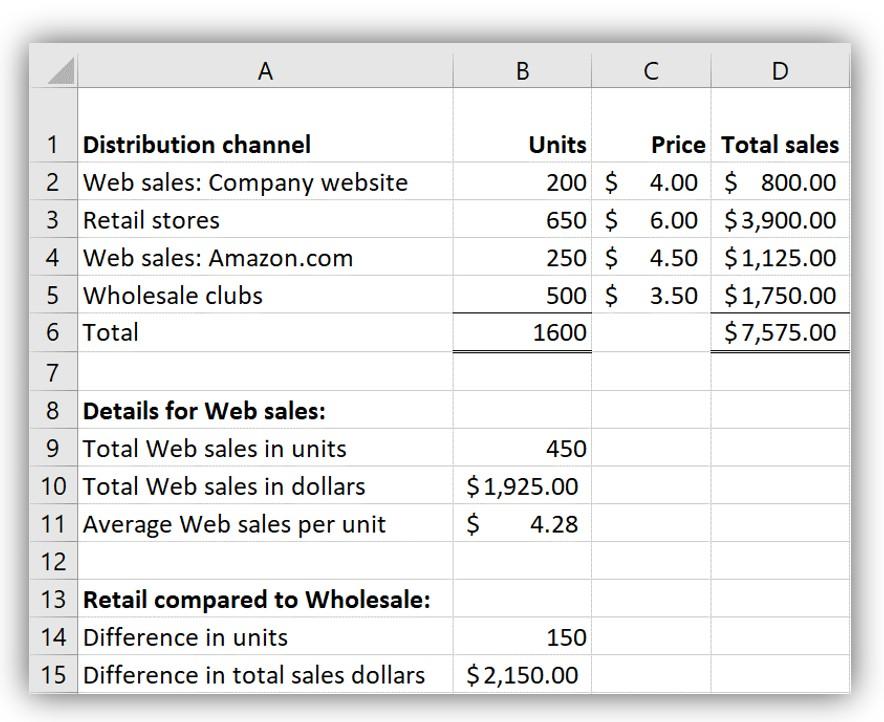
Formulas in each cell should be:
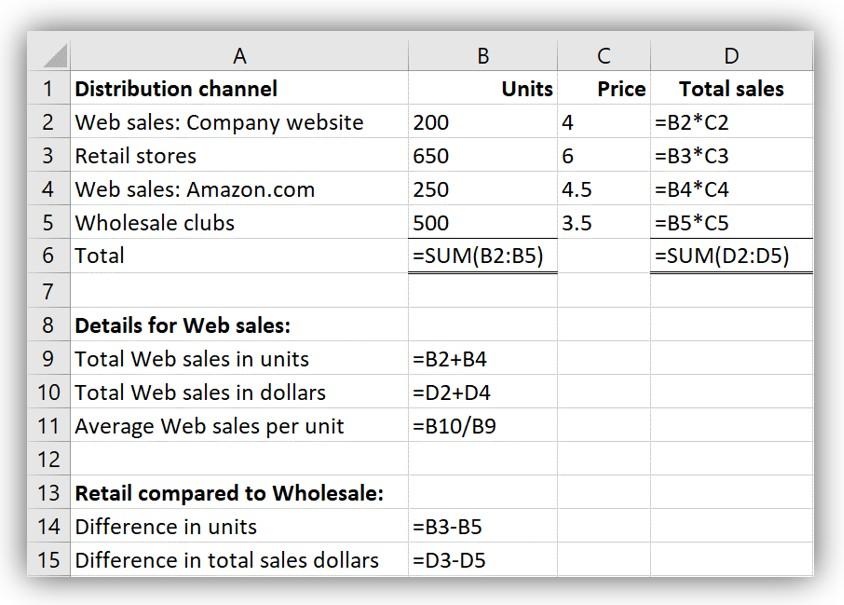
1. 386
2. NJ-Disability
3. 693
4. 9
5. 57516
6. See below
a. $679.55
b. 12
c. $8,154.59
7. 56243
8. Click in the cell in the upper left corner of the worksheet (the intersection of the row and column headers)
Excel file should show:

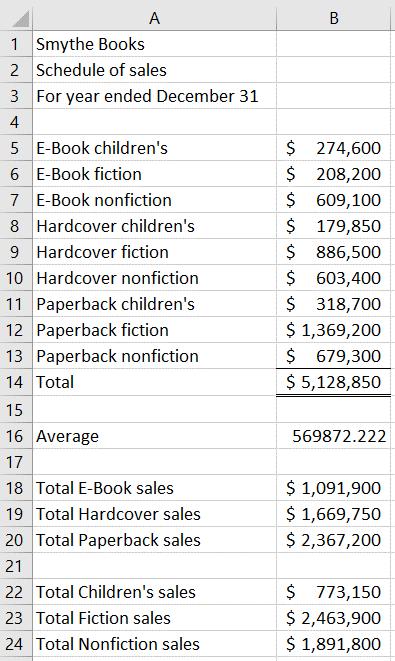
Formulas in each cell should be:

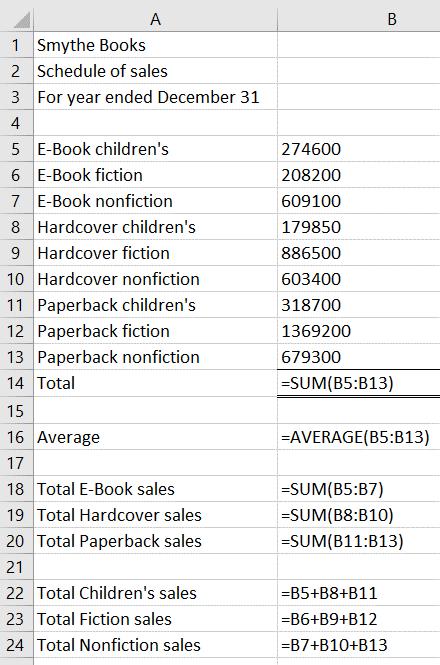
Problems (Group A)
Req. 1
(45–60 min.) P1-34A
Planning Directing Controlling
Sales Increase sales
Repairs Increase volume of repairs
Lessons Increase number of lessons given
Setting competitive prices. Examine sales reports.
Streamline process to save time. Set competitive prices; generate reports showing time used for each type of repair.
Find out what customers want and need. Observe competitors for prices and lessons offered. Improve teacher qualifications.
Web development Increase Web traffic Improve design of website. Offer more products online. Make shopping easier and more intuitive. Increase marketing efforts.
Accounting Implement ERP system to monitor department activities and record finances
Human resources Decrease employee turnover
Train employees on new system. Find potential flaws in the system and fix before implementation.
Monitor sales numbers and prices from different products and locations over time. Investigate variances.
Track total number of repairs and see if more repairs are being made and if time is utilized efficiently.
Examine number of lessons given per instrument.
Monitor Web traffic by having an online counting device. Look at sales numbers to see if people are just surfing or actually buying merchandise.
Track employee work schedules to stay on time. Double-check entries to ensure system is working properly.
Hire employees who are “a good fit” for the company. Raise employee morale; set clear job descriptions. Give feedback to employees.
Monitor both involuntary and voluntary turnover. Interview employees to determine potential problems with the workplace.
Req. 2
Planning
Sales A sales budget for the entire company and each individual product at each location is needed.
Repairs Labor budgets would be needed to determine the time taken to repair instruments and if hiring more repair staff would be feasible.
Lessons Budgets for types of lessons offered, time needed per lesson taught, and market analysis to determine which lessons potential customers want.
Web development
An expense budget is needed to ensure money is spent efficiently. A budget would also be needed to set Web traffic goals.
Accounting Time budgets as well as expense budgets are needed.
Human resources
Employee satisfaction surveys and feedback reports.
Directing
Analyze sales reports to monitor type and amount of sales made. Prices would be analyzed using these reports and market analysis of competitors.
Employee training programs would be used. Monitor time taken per repair for each member of repair staff.
Ensure customer satisfaction by hiring qualified staff. Analyze market analysis to determine market needs and proper pricing schemes.
Monitor department expenses and website visits using online counting program.
Train employees on new system to keep within time budget. Monitor expenses closely.
Active relationship between management and employees. Management would record needs and suggestions made by employees in feedback system.
Controlling
Compare budgets with actual sales numbers. Investigate variances to take corrective actions if needed. Change prices if deemed appropriate.
Compare budgets with actual results. Investigate variances and take corrective action if needed.
Compare budgets with actual results. Use customer feedback to improve lessons. Make changes if needed.
Compare budgeted expenses with actual and compare expected Web traffic with actual. Investigate variances and make changes as needed.
Compare budget with actual numbers. Investigate variances and make changes if needed.
Consider employee suggestions and enact changes if needed.
Note: All the information needed in the table above would be generated almost entirely by the managerial accounting system. Managerial accounting systems provide much of the information needed for internal decision making, while financial accounting systems are geared towards external financial reporting.
a. If the goods have been received, postponing recording of the purchases understates liabilities. This is unethical and inconsistent with the IMA standards even if the supplier agrees to delay billing.
b. The software has not been sold. Therefore, it would be inconsistent with the IMA standards to record it as sales.
c. Delaying year-end closing incorrectly records next year’s sales as this year’s sales. This is clearly wrong and unethical, and it is inconsistent with the IMA standards.
d. The appropriate allowance for bad debts is a difficult judgment. The decision should not be driven by the desire to meet a profit goal. It should be based on the likelihood that the company will collect. We cannot determine this without more information. However, because the company emphasizes earnings growth, which can lead to sales to customers with weaker credit records, reducing the allowance seems questionable. This strategy is likely inconsistent with the IMA standards.
e. If the maintenance is postponed, there is no transaction to record. This strategy is beyond the responsibility of the controller, so it does not violate IMA standards.
Strategies a, b, and c are clearly unethical and inconsistent with the IMA standards of integrity, credibility, and perhaps competence. Strategy d is likely unethical, but we cannot be certain without more information. The controller should resist attempts to implement a, b, and c, and she should gather more information about d. If the president ignores the controller’s concerns and still insists that these strategies be implemented, then the controller should probably resign rather than continuing to work for a company that engages in unethical behavior.
Req. 1
Benefits if the project is successful:
Req. 2
Costs
Because the expected value of the benefits is less than the total costs, the company should not undertake the project.
Req. 3
The CEO formed a team to evaluate the feasibility of installing an ERP system for two reasons. First, the project was probably too big for one person. Second, representatives of the different functional business areas have different knowledge and information to contribute.
a. Estimating software costs systems specialist
b. Estimating cost of loading data into the new ERP system management accountant systems specialist
c. Customize the ERP software management accountant systems specialist
d. Estimate customization costs all team members
e. Estimate training costs human resource director
f. Savings from more efficient order processing systems specialist management accountant
g. Savings from streamlining the manufacturing process plant engineer plant foreman
h. Evaluate the effects of integrating purchasing, production, marketing, and distribution into a single system plant foreman
i. Estimate increase in sales from higher customer satisfaction marketing director
j. Estimate benefits and costs all team members
Student answers may vary. The main point is that different team members contribute different knowledge.
Value of
(lower labor costs)………….………..
Because the benefits exceed the costs, a cost-benefit analysis suggests that the company should proceed with the online ordering system.
Req. 1
The expected value of the benefits is the labor cost savings of $935,000. This is a downward revision from what was originally estimated in P1-37A.
Req. 2
Expected value of benefits……….……………............ $935,000
P1-37A)………………...…………….
The revised estimates mean the expected costs are greater than the expected benefits. The quantitative analysis suggests that the company should not undertake the project. Before deciding, the company should carefully consider other factors like those listed in Req. 3
Req. 3
Other factors management should consider before making a final decision include the following:
The difficulty and costs of laying off employees may reduce the expected benefits.
Employee layoffs may hurt morale and efficiency in other areas of the company, thus increasing costs.
Electronic order processing should reduce human errors, thereby reducing costs.
Providing dealers with current availability, price information, and timely order processing will help the company manage and reduce its inventories.
Student answers to Req. 3 may vary.
Problems (Group B)
Req. 1
Planning
Sales Increase sales
Directing
Setting competitive prices. Examine sales reports.
Repairs Increase volume of repairs
Customization Increase number of custom systems built
Web development Increase Web traffic
Accounting Implement ERP system to monitor department activities and record finances
Human resources Decrease employee turnover
Streamline process to save time. Set competitive prices; generate reports showing time used for each type of repair.
Find out what customers want and need. Observe competitors for prices and options offered. Improve employee certification and offer higher-quality parts.
Improve design of website. Offer more products online. Make shopping easier and more intuitive. Increase marketing efforts.
Train employees on new system. Find potential flaws in the system and fix before implementation.
Hire employees who are “a good fit” for the company. Raise employee morale; set clear job descriptions. Give feedback to employees.
Controlling
Monitor sales numbers and prices from different products and locations over time. Investigate variances.
Track total number of repairs and see if more repairs are being made and if time is utilized efficiently.
Examine number of computer systems built per type (multimedia, gaming, etc.).
Monitor Web traffic by having an online counting device. Look at sales numbers to see if people are just surfing or actually buying merchandise.
Track employee work schedules to stay on time. Double check entries to ensure system is working properly.
Monitor both involuntary and voluntary turnover. Interview employees to determine potential problems with the workplace.
Planning
Sales Haas would need a sales budget for the entire company and each individual product at each location.
Customization Budgets for types of computers offered, time needed per job, and market analysis to determine which computers potential customers want.
Repairs Labor budgets would be needed to determine the time taken to repair instruments and if hiring more repair staff would be feasible.
Web development Haas would need an expense budget to ensure money is spent efficiently. A budget would also be needed to set Web traffic goals.
Accounting Haas would need time budgets as well as expense budgets.
Human resources
Employee satisfaction surveys and feedback reports.
Directing
Analyze sales reports to monitor type and amount of sales made. Prices would be analyzed using these reports and market analysis of competitors.
Ensure customer satisfaction by hiring qualified staff. Research quality of available parts. Analyze market analysis to determine market needs and proper pricing schemes.
Employee training programs would be used. Monitor time taken per repair for each member of repair staff.
Monitor department expenses and website visits using online counting program.
Controlling
Compare budgets with actual sales numbers. Investigate variances to take corrective actions if needed. Change prices if deemed appropriate.
Compare budgets with actual results. Use customer feedback to improve custom builds. Make changes if needed.
Compare budgets with actual results. Investigate variances and take corrective action if needed.
Compare budgeted expenses with actual and compare expected Web traffic with actual. Investigate variances and make changes as needed.
Train employees on new system to keep within time budget. Monitor expenses closely.
Active relationship between management and employees. Management would record needs and suggestions made by employees in feedback system.
Compare budget with actual numbers. Investigate variances and make changes if needed.
Consider employee suggestions and enact changes if needed.
Note: All the information needed in the table above would be generated almost entirely by the managerial accounting system. Managerial accounting systems provide much of the information needed for internal decision making, while financial accounting systems are geared toward external financial reporting.
(15–20 min.) P1-40B
a. If advertising is postponed, there is no transaction to record. This strategy is beyond the responsibility of the controller, so it does not violate IMA standards.
b. The value of each individual sales return may not be material. However, even if each is small on an individual basis, in aggregate, they may amount to a material level. Failing to record sales returns and allowances will falsely inflate this year’s sales, so it is inconsistent with the IMA standards.
c. If customers actually place orders in December and those orders are filled, then a transaction has occurred that can legitimately be recorded. This strategy does not violate IMA standards.
d. The appropriate allowance for bad debts is a difficult judgment. The allowance for bad debts should not be driven by the desire to meet a profit goal. It should be based on the collectability of the accounts receivable. Without more information on the collectability of accounts receivable, it is not clear whether this strategy would violate IMA standards.
e. The goods in the public warehouses have not yet been sold and therefore should not be recorded as sales. This strategy is inconsistent with the IMA standards.
Strategies b and e are clearly unethical and violate the IMA standards of integrity, credibility, and perhaps competence. Without more information, it is not clear whether strategy d violates the IMA standards. The controller should resist attempts to implement b and e and should gather more information about d. If the president ignores the controller’s concerns, then the controller should probably resign rather than continuing to work for a company that engages in unethical behavior.
(15–20 min.) P1-41B
Req. 1
Benefits if the project is successful:
2
Because the expected value of the benefits is greater than the total costs, the company should undertake the project.
Req. 3
A team was formed to evaluate the feasibility of installing an ERP system for two reasons. First, the project was probably too big for one person. Second, the representatives of the different functional business areas have different knowledge and information to contribute.
a. Estimating software costs systems specialist
b. Estimating cost of loading data into the new ERP system management accountant systems specialist
c. Customize the ERP software management accountant systems specialist
d. Estimate customization costs all team members
e. Estimate training costs human resource director
f. Savings from more efficient order processing systems specialist management accountant
g. Savings from streamlining the manufacturing process plant engineer plant foreman
h. Evaluate the effects of integrating purchasing, production, marketing, and distribution into a single system plant foreman
i. Estimate increase in sales from higher customer satisfaction marketing director
j. Estimate benefits and costs all team members
Student responses may vary. The main point is that different team members contribute different knowledge.
Because the benefits exceed the costs, a cost-benefit analysis suggests that the company should proceed with the online ordering system.
Req. 1
The expected value of the benefits is the labor cost savings of $936,000. This is a downward revision from what was originally estimated in P1-42B.
Req. 2
Expected value of benefits……….……………................................ $936,000
The revised estimates mean the expected costs are greater than the expected benefits. The quantitative analysis suggests the company should not undertake the project. Before deciding, the company should carefully consider other factors like those listed in Req. 3
Req. 3
Other factors the company should consider before making a final decision include the following:
The difficulty and costs of laying off employees may reduce the expected benefits.
Employee layoffs may hurt morale and efficiency in other areas of the company, thus increasing costs.
Electronic order processing should reduce human errors, thereby reducing costs.
Providing dealers with current availability, price information, and timely order processing will help the company manage and reduce its inventories.
Student answers to Req. 3 may vary.
Serial Case
Burburr’s managers use accounting information for much more than preparing annual financial statements. They use managerial accounting information to guide their actions and decisions. These decisions might include opening a new hotel tower and nightclub, renovating old hotel rooms and restaurants, or sourcing required materials from different suppliers. Management accounting information helps Burburr’s management decide whether any or all of these actions will help accomplish the company’s ultimate goals.
Burburr’s management is continually making decisions while it plans, directs, and controls operations. Burburr Resorts & Hotels must decide where to open new hotels, which restaurants to refurnish, what prices to set for rooms and meals, what items to offer on its menu, and so forth. Managerial accounting gathers, summarizes, and reports on the financial impact of each of these decisions.
Student answers will vary
C1-44
Discussion & Analysis
A1-45
1. What are the three main areas of management’s responsibility? How are these three areas interrelated? How does managerial accounting support each of the responsibility areas of managers?
The three main areas of management’s responsibility are planning, directing, and controlling. Planning involves setting goals, directing means overseeing the day-to-day operations that support those goals, and controlling means evaluating the results of those operations. Budgets, variance analysis, and cost-volume-profit analysis are some of the ways managerial accounting supports the responsibility areas of management.
2. What is the Sarbanes-Oxley Act of 2002 (SOX)? How does SOX affect financial accounting? How does SOX impact managerial accounting? Is there any overlap between financial and managerial accounting in terms of the SOX impact? If so, what are the areas of overlap?
The Sarbanes-Oxley Act of 2002 is a congressional act that enhances internal control and financial reporting requirements and establishes new regulatory requirements for publicly traded companies and their independent auditors. SOX requires company CEOs and CFOs to assume responsibility for the financial statements and disclosures. In addition, they assume responsibility for establishing an adequate and internal control structure and procedures for financial reporting. Managerial accounting is affected by SOX because internal control affects the entire company and managerial accounting systems provide information that is published in the company’s financial reporting.
3. Why is managerial accounting more suitable for internal reporting than financial accounting?
Managerial accounting is more suitable than financial accounting for internal reporting because management needs timely information that will assist them in planning, analyzing, and making decisions. They cannot wait for the historical information that is provided by financial accounting. Managerial accounting information is futureoriented.
4. How can what is taught in managerial accounting help you in careers other than accounting?
All professions require decision making. Techniques taught in managerial accounting can help in all careers.
5. A company currently has all its managerial accountants reporting to the controller. What might be inefficient about this organizational structure? How might the company restructure? What benefits would be offered by the restructuring?
Having all managerial accountants report to the controller is the traditional way of structuring companies in the past when management accountants were viewed as recorders of historical transactions. Now the company should consider how management accountants make a better fit in cross-functional teams, which consist of employees representing various functions of the company. This would allow the management accountants to use their consultant and advisor roles more effectively for the company.
6. What skills are required of a management accountant? In what college courses are these skills taught or developed? What skills would be further developed in the workplace?
Today’s management accountants need the following skills: (1) technical competencies such as computer skills and decision analysis, (2) nontechnical competencies such as communication skills and leadership, (3) critical thinking, and (4) accounting knowledge.
These skills are taught and developed in a variety of college courses: accounting, management, communication, computer science, finance, and any courses that require students to work in teams and practice their communication skills. All skills would be further developed in the workplace especially as each company has its own needs and requirements based on its industry and culture.
7. What is the Institute of Management Accountants (IMA)? What is the Association of International Certified Professional Accountants (AICPA)? How could being a member of a professional organization help a person’s career?
The IMA is the professional association for management accountants. The Association of International Certified Professional Accountants is the world’s largest association representing the accounting profession. Being a member of a professional organization can help a person’s career because the association often provides certification programs, practice development, education, and networking.
8. How might a Certified Management Accountant (CMA) certification benefit a person in his or her career? What skills are assessed on the CMA exam?
Most employers do not require the CMA certification, but it tends to command a higher salary and higher level positions for those who hold the certification. The CMA exam focuses on managerial accounting topics as well as economics and business finance.
9. What are the four ethical standards in the Institute of Management Accountants’ Statement of Ethical Professional Practice? Describe the meaning of each of the four standards. How does each of these standards impact planning, directing, and controlling?
The four ethical standards are competence, confidentiality, integrity, and credibility.
Competence includes the following:
Maintain an appropriate level of professional expertise by continually developing knowledge and skills.
Perform professional duties in accordance with relevant laws, regulations, and technical standards.
Provide decision support information and recommendations that are accurate, clear, concise, and timely.
Recognize and communicate professional limitations or other constraints that would preclude responsible judgment or successful performance of an activity.
Confidentiality includes the following:
Keep information confidential except when disclosure is authorized or legally required.
Inform all relevant parties regarding appropriate use of confidential information.
Monitor subordinates’ activities to ensure compliance.
Refrain from using confidential information for unethical or illegal advantage. Integrity includes the following:
Mitigate actual conflicts of interest. Regularly communicate with business associates to avoid apparent conflicts of interest. Advise all parties of any potential conflicts.
Refrain from engaging in any conduct that would prejudice carrying out duties ethically.
Abstain from engaging in or supporting any activity that might discredit the profession.
Credibility includes the following:
Communicate information fairly and objectively.
Disclose all relevant information that could reasonably be expected to influence an intended user’s understanding of the reports, analyses, or recommendations.
Disclose delays or deficiencies in information, timeliness, processing, or internal controls in conformance with organization policy and/or applicable law.
Each of the standards affects all three of managers’ responsibilities.
10. What business trends are influencing managerial accounting today? How do these trends impact management accountants’ roles in the organization?
Some business trends, such as the shifting economy, have required managers to become knowledgeable in services as well as products. Global competition also has required managers to become skilled in e-commerce. Lean thinking and Six Sigma require management accountants to analyze new quality costs and develop costs and benefits for quality improvement initiatives. Sustainability, social responsibility reporting, and the triple bottom line have increased the types and amount of information the management accountant must obtain. The abundance of data from the Internet and other technology has resulted in the management accountant honing data analytic skills.
11. The effect of sustainability on the planet (environment) is probably the most visible component of the triple bottom line. For a company with which you are familiar, list two examples of its sustainability efforts related to the planet.
Student responses will vary.
12. One controversial area regarding sustainability is whether organizations should use their sustainability progress and activities in their advertising. Do you think a company should publicize their sustainability efforts? Why or why not?
Student responses will vary.
Application & Analysis Mini Cases
Basic Discussion Questions
A1-46
1. When you think of an accountant, whom do you picture? Do you personally know anyone (family member, friend, relative) whose chosen career is accounting? If so, does the person “fit” your description of an accountant or not?
Student answers will vary.
2. Before reading this chapter, what did you picture accountants doing, day-in and day-out, at their jobs? From where did this mental picture come (e.g., movies, first accounting class, speaking with accountants, etc.)?
Student answers will vary.
3. What skills do employers value highly? What does that tell you about “what accountants do” at their companies?
The skills required by employers are (1) technical competencies such as computer skills and decision analysis, (2) nontechnical competencies such as communication skills and leadership, (3) critical thinking, and (4) accounting knowledge. Today, management accountants are business advisors and analysts.
Management accountants must ensure that the company’s financial records adequately capture economic events. They help design the information systems that capture and record transactions and make sure that the information system generates accurate data. They use professional judgment to record nonroutine transactions and adjust the financial records as needed. Because management accountants have been freed, due to technology, from the routine mechanical work, they spend more time planning, analyzing, and interpreting accounting data and providing decision support.
4. Many accounting majors start their careers in public accounting. Do you think most of them stay in public accounting? Discuss what you consider to be a typical career track for accounting majors.
According to the IMA, about 85% of all accountants work in organizations, so it appears that most accounting majors do not stay in public accounting.
Student answers will vary concerning the typical career track for accounting majors because there are many. It would start with the decision to enter public, corporate, governmental, or independent accounting.
5. If you are not an accounting major, how do the salaries of accountants compare with your chosen field? How do the opportunities compare (i.e., demand for accountants)?
Student answers will vary depending on their chosen field.
Ethics at Enron
Basic Discussion Questions
1. Do you think such behavior is common at other companies, or do you think this was a fairly isolated event?
2. How important is the “tone at the top” (the tone set by company leadership)?
3. Do you think you could be tempted to follow along if the leadership at your company had the same mentality as the leadership at Enron, or do you think you would have the courage to “just say no” or even be a “whistleblower”?
4. Why do you think some people can so easily justify (at least to themselves) their unethical behavior?
5. In general, do you think people stop to think about how their actions will affect other people (e.g., the elderly in California who suffered due to electricity blackouts) or do they just “do their job”?
6. What was your reaction to the psychology experiment shown in the movie? Studies have shown that unlike the traders at Enron (who received large bonuses), most employees really have very little to gain from following a superior’s directive to act unethically. Why then do some people do it?
7. Do you think people weigh the potential costs of acting unethically with the potential benefits?
8. You are a business student and will someday work for a company or own a business. How will watching this movie impact the way you intend to conduct yourself as an employee or owner?
9. The reporter from Fortune magazine asked the question, “How does Enron make its money?” Why should every employee and manager (at every company) know the answer to this question?
10. Considering the “mark-to-market” accounting that enabled Enron to basically record any profit it wished to record, can you understand why some of the cornerstones of financial accounting are “conservatism” and “recording transactions at historical cost”?
11. How did employees of Enron (and employees of the utilities company in Oregon) end up losing billions in retirement funds?
Student answers will vary.
Decision Case
Sustainability
A1-48
This is an open-ended project, without definite solutions. However, the following observations may be helpful. This project works best with groups of four or five students. The person interviewed could be identified through a connection of one of the students, a connection made by the instructor, or a connection through the school.
Requiring students to answer the first four questions before the interview will help ensure that they are prepared for the interview. It is important that students be prepared so they can make a favorable impression on the interviewee (for the school and future employment!) and so they do not waste the interviewee’s time. If the company is of any reasonable size, they should be able to gather information from the library or the Internet.
1. What is the company’s primary product or service?
2. Does your company have a stated policy on sustainability? What is this policy?
3. How would this manager define “sustainability”? Is the manager’s definition similar to the definition of “sustainability” in the chapter?
4. Regardless of whether the company has a sustainability policy or not, what sustainability efforts does the company make with respect to the environment? For example, does the company recycle its waste? What specific types of waste are recycled? Does the company purchase recycled-content products?
5. Is the amount (or percentage) of waste that is recycled tracked in a reporting system? Who gets reports on the organization’s recycling efforts?
6. How does the company measure its impact on the environment (if it does)? (For example, does it measure its carbon footprint in total? Does it measure the carbon footprint of individual projects?)
7. Does the company do any external reporting on sustainability? If so, how long has the company been reporting on its sustainability efforts? If the company does not do any sustainability reporting at the current time, does it anticipate starting to report on its sustainability efforts in the near future?
8. In the manager’s opinion, is sustainability important within that organization’s industry? Why or why not?
Student responses to the preceding questions will vary by student and organization.
1. The ethical issue involves providing access to financial and other information about the company where Sancha works to other individuals, in this case her boyfriend. Sancha has made the company’s financial information available through conversations, phone conversations, and emails obtained through a cell phone passcode.
2. Sancha has a responsibility to keep the company’s information confidential. Each IMA member has a responsibility to keep information confidential except when disclosure is authorized or legally required. She also has a responsibility to safeguard the company’s information from others who could profit from inside information. She has made the company’s information available to a third party who could profit from the information.
3. The ethical standard that Sancha may have violated is confidentiality. She had a responsibility to keep her work details confidential. Jaya, on the other hand, has committed illegal acts (insider trading at a minimum).
If Sancha discovers what Jaya has been doing, she may have a responsibility to report his actions. If they get married before she discovers his wrongdoings, then that muddies the waters further.
Student answers will vary.
Note from author: This case was based loosely on a real-life legal case. For additional information, please see SEC Sues 26-Year Old On Charges He Made $200,000 Insider Trading Off Ex-Girlfriend's Work Project http://www.businessinsider.com/toby-scammell-insider-trading-girlfriend-bain-capital-marvell-disney-2011-8
1. Types of financial accounting information that may be generated or recorded include
a. Ticket sales revenue
b. Operating costs including salaries, utilities, cost of props, etc.
2. Information needed by Hamilton producers to calculate return of original investment and to keep show open
a. Financial accounting system
i. Original investment costs
ii. Ticket revenues to date
iii. Operating costs to date
b. Managerial accounting system
i. Projected ticket revenues
ii. Projected operating costs
3. Information needed by Mamma Mia! producers to decide to move to a different theater
a. Financial accounting system
i. Ticket revenues to date
ii. Operating costs to date
b. Managerial accounting system
i. Projected rental costs of new theater for upcoming year
ii. Projected rental costs of current theater for upcoming year
iii. Projected operating costs of new theater
iv. Projected operating costs of current theater
v. Projected ticket revenues in new theater
vi. Projected ticket revenues in current theater
vii. Moving cost
4. Information needed by Beetlejuice producers to close the show early and by a different producer to reopen the show in another theater
a. Financial accounting system
i. Ticket revenues to date
ii. Operating expenses to date
b. Managerial accounting system
i. Projected ticket revenues
ii. Projected operating costs
iii. Costs of reopening (moving, redesign, etc.) in new theater
iv. Projected ticket revenues in new theater
v. Projected operating costs of new theater
Student answers will vary.
Chapter 1 Introduction to Managerial Accounting
The chapter introduces managerial accounting along with the fundamental principle of the text, which is the importance of using managerial accounting data in decision making. Students are introduced to the importance of such data in decision making by discussing the primary responsibilities of a manager: planning, directing, and controlling. To help students understand the importance of managerial accounting, financial and managerial accounting are contrasted and compared. Managerial accounting has internal users relying on relevant information prepared specifically for management’s needs, whereas financial accounting has external users using reliable and objective information in the form of financial statements.
The role of managerial accounting is illustrated by comparing the perception and reality of accounting and through the presentation of a typical organizational structure, as well as the roles and skills required of management accountants. In addition to their traditional roles, management accountants also play an important role in planning, analyzing, and interpreting accounting data and providing decision support. Management accountants are often referred to as business advisors, analysts, and finance professionals. To fulfill these roles, management accountants today must possess both technical and nontechnical competencies, such as solid knowledge of both financial and managerial accounting, analytical skills, knowledge of how a business functions, ability to work on a team, and oral and written communication skills. Management accountants are trusted and valued business advisors. Managerial accounting knowledge is important to all types of careers, including sales professionals and musicians. The Institute of Management Accountants (IMA) is the professional association for management accountants, which also develops standards of ethics and standards of professional conduct. It provides a forum for research, practice development, education, knowledge sharing, and advocacy of the highest ethical and best practices in management accounting and finance. The Certified Management Accountant (CMA) certification, which reinforces the technical skills required for management accountants, is issued by the IMA and requires professionals to pass a rigorous two-part exam, gain two years of relevant professional experience, and maintain continuing professional education. The IMA has also developed principles and standards to help management accountants deal with ethical challenges.
The Decision Guidelines and Summary Problems are useful examples of questions and outlines that help students summarize their learning and reinforce the objectives of the chapter. Two sets of Decision Guidelines and Summary Problems are present in this chapter. The first set of Guidelines reinforces the role of managerial accounting and the management accountant in an organization. The first set of Summary Problems reinforces the concepts introduced in the first part of the chapter. Topics include management’s responsibilities, managerial versus financial accounting, and ethical responsibilities.
The next section of the chapter presents the implications of business trends on management accounting. Business trends discussed include enterprise resource planning, critical thinking, implications of a knowledge economy, sustainability, social responsibility, and the triple bottom line. The section ends with a discussion of the Sarbanes-Oxley Act of 2002.
The next section of the chapter focuses on data analytics, which is broadly defined as using data to make good business decisions. Data analytics is distinguished for other forms of data collection by the sheer amount and variety of data collected. The benefits of data analytics discussed include adding more factbased information to the decision-making process, helping businesses make quicker decisions, increasing the efficiency of internal operations, helping companies better adapt and respond to customers, and driving
Copyright
company innovations. The data analytics process begins with identifying which question needs to be answered or which issue needs to be solved and ends with monitoring the results. In summary, data analytics can help to describe what happened, why it happened, what will happen next, and what should possibly be done about it. These insights are then used to help guide management decisions and actions.
The final section of the chapter discusses the fundamental features of Excel. The elements of an Excel workbook are illustrated by discussing the top and bottom of a worksheet. Students are shown how to select cells, format cells, and navigate a worksheet. In addition, mathematical operations and functions are discussed. In the last learning objective of every chapter, students will learn how to use a specific Excel tool for data analytics in order to gain confidence in using Excel to help solve business issues.
The second set of Decision Guidelines illustrates some of the decisions managers need to consider in response to changes in the regulatory and business environment. An additional Summary Problem allows students to use cost-benefit analysis to determine whether a company should expand or not.
Learning Objectives
After studying Chapter 1, your students should be able to:
1. Identify managers’ three primary responsibilities
2. Distinguish financial accounting from managerial accounting
3. Describe the roles and skills required of management accountants within the organization
4. Describe the role of the Institute of Management Accountants (IMA) and apply its ethical standards
5. Discuss the business trends and regulations affecting management accounting
6. Describe the benefits of data analytics
7. Apply Excel by performing basic Excel operations
Teaching Outline
I. What Is Managerial Accounting?
A. Managers’ Three Primary Responsibilities
1.Exhibit 1-1: Managers’ Three Primary Responsibilities
2.Planning
3.Directing
4.Controlling
B. A Road Map: How Managerial Accounting Fits In
1.Managerial accounting building blocks
2.Determining unit cost (product costing)
3.Making decisions
4.Planning
5.Controlling and evaluating
C. Differences Between Managerial Accounting and Financial Accounting
1.Exhibit 1-2: Managerial Accounting Versus Financial Accounting
II. What Role Do Management Accountants Play?
A. The Role of Management Accountants
1.Exhibit 1-3: The Perception and the Reality
2.What is the business issue, event, or problem, and how can accounting help solve it?
3.What are the “gray areas”?
4.What are the implications for the business if the accounting information used in the decision is “wrong”?
B. The Skills Required of Management Accountants
1.Exhibit 1-4: Technical and Nontechnical Competencies Needed by Management Accountants
C. Managerial Accounting Is Important to All Careers
1.Entrepreneurs
2.Business management
3.Marking and sales
4.Nonbusiness majors
D. Accounting within the Organizational Structure
1.Exhibit 1-5: Typical Organizational Structure
2.Chief operating officer (COO) and chief financial officer (CFO)
3.Treasurer and controller
4.Internal audit function and audit committee
E. Professional Associations
1.Institute of Management Accountants (IMA)
2.Certified Management Accountant (CMA)
3.American Institute of Certified Public Accountants (AICPA)
4.Chartered Global Management Accountant (CGMA)
F. Average Salaries of Management Accountants
G. Professional Ethics
1.IMA’s Statement of Ethical Professional Practice
a. Competence
b. Confidentiality
c. Integrity
d. Credibility
2.Exhibit 1-6: Summary of Ethical Standards
3.Exhibit 1-7: IMA Statement of Ethical Professional Practice
H. Examples of Ethical Dilemmas
1.Unethical versus illegal behavior
III. What Business Trends and Regulations Affect Management Accounting?
A. Data Analytics and Critical Thinking
1.Enterprise resource planning (ERP)
2.Critical thinking
3.Knowledge economy
4.Globalization
5.Sustainability, social responsibility, and the triple bottom line
6.Exhibit 1-8: The Three Pillars of Sustainability
7.Exhibit 1-9: Sustainability as the Intersection of Three Factors
8.Sarbanes-Oxley Act of 2002 (SOX)
9.Exhibit 1-10: Some Important Features of SOX
IV. Why and How Do Managers Use Data Analytics?
A. The Heart of Data Analytics
B. Benefits of Data Analytics
C. Data Analytics Process
1.Business issue
2.Data
3.Tools and technology
4.Analysis and insights
5.Communicate
6.Follow-through
V. What Are the Fundamental Excel Features?
A. Elements of an Excel Workbook
1.Exhibit 1-11: Top of an Excel Workbook
2.Exhibit 1-12: Bottom of an Excel Workbook
B. Selecting Cells
1.Exhibit 1-13: Selecting a Large Range of Data
C. Formatting Cells
1.Exhibit 1-14: Formatting Numbers in Cells
D. Navigating a Worksheet
1.Exhibit 1-15: Navigating a Large Data Set
E. Formulas and Relative Cell References
1.Mathematical operations
a. Exhibit 1-16: Mathematical Operations and Symbols for Formulas
b. Exhibit 1-17: Additional Mathematical Symbols
2.Cell references
a. Relative
b. Absolute
c. Exhibit 1-18: Using Dollar Signs to Denote an Absolute Cell Reference
3.Copy/paste and fill handles
a. Exhibit 1-19: Copy and Paste from Home Tab
b. Exhibit 1-20 Use Fill Handle to Copy Formulas to Adjacent Cells
F. Functions and Specifying Data Ranges
1.Functions
a. Exhibit 1-21: Function Library Under Formulas Tab on Ribbon
b. Exhibit 1-22: Example of Dialog Box
2.Specifying data ranges
a. Exhibit 1-23: Specifying Data Ranges
Key Topics
This chapter is the foundation for the rest of the text. Without a good understanding of this chapter, students will have a difficult time understanding the remaining content.
After covering managers’ three primary responsibilities, consider offering the following example: A manager of a cleaning services company may wish to expand its service from cleaning only private homes to also cleaning corporate offices and plants. This goal is then developed into a budget (planning). That budget is analyzed thoroughly to determine both the price points and how to market the service (directing). After comparing the budget to the actual results, the managerial accountant determines that the expansion into the new market is somewhat slower than expected and decides to change its marketing strategy (controlling). Decision making occurs at all levels of the process. For example, if the marketing strategy works and the corporation proceeds toward meeting its goals, the managerial accountant focuses attention on which new services will be offered, how much to charge for the services, and if loyalty discounts should be given to existing customers who purchase these services.
In teams or in partners, have students complete S1-1 Categorize managers’ responsibilities. Call on a student to give the answers.
At this point, accounting students have most likely been exposed only to financial accounting. Students sometimes have a difficult time making the adjustment from financial to managerial accounting. Use Exhibit 1-2 to emphasize the differences between financial and managerial accounting. This is a great time to review the role of financial accountants in our society and then explain the role of management accountants. In doing so, be sure to also point out that the study of financial accounting focuses on external decision makers, whereas managerial accounting focuses on internal decision makers.
Here’s an example: A manager is setting the price of items in the store. In order to make this decision, the manager needs to know the cost of the items, other organizational costs, sales prices for similar items, and so on. Of course, these matters are of great importance to an internal management accountant. An external accountant would not make the same decisions; instead, he or she would make decisions based on information contained in the financial statements.
In teams or in partners, have students complete E1-18A Identify users of accounting information. Point out that most decisions impact nonaccountants and stress the importance for nonaccounting majors to understand managerial accounting.
Many students love to discuss ethical issues. Sometimes ethical issues may be presented to students in a casual way. Here is an example: A supervisor requests that you don’t record your overtime on your timesheet. This will allow the supervisor to stay within the budget, but it doesn’t properly reflect what is happening within the organization. You feel pressure from the supervisor. Ask students what ethical issues are involved in this example and what steps they would take to resolve the ethical dilemma. Ask students how many of them were left unsupervised when they first started a new job. How accurate was their work? Would the students feel responsible for making an error if they had been improperly trained?
Ask students to assume they work for a company. In this scenario, they will have heard that their company is being sold. The information is confidential, and they can’t speak about it. What would they do if their best friend wanted to buy stock?
You can use E1-19A Classify ethical responsibilities as a group or partner exercise.
Copyright
When discussing the Sarbanes-Oxley Act, remember that many of today’s students probably don’t remember business before accounting scandals. Students have likely become cynical about accounting practices based on news media. Ask students to identify what would give them confidence in an organization’s accounting decisions.
Many students today are concerned about the impact businesses have on the environment as well as if companies are acting in a socially responsible manner. Discuss the concept of the triple bottom line and the interrelationships among profit, people, and planet. What are the difficulties in measuring the impact a company has on people and planet? Ask students if they think that a company concerned about people and planet can be profitable. Have students share examples of companies that have “green initiatives.” Do these companies advertise that they are “green”? What are some companies that the students think are socially responsible? Have them share examples of what they think companies should be doing to be considered socially responsible. Would a business’s actions (or lack of action) in these areas affect their behavior as consumers?
Integrated reporting is about generating a report that includes essential information about an organization’s strategy, governance, performance, and prospects that lead to the creation of value over the short, medium, and long term. It must be a holistic, balanced, and future-looking report as compared to traditional financial statements. It must include all material elements that create value for the organization. For this reason, large companies use enterprise resource planning (ERP) systems that can integrate all of a company’s worldwide functions, departments, and data.
In the shifting economy, ask students if they think Apple manufactures its own chargers or if they are manufactured by an outside company. Ask them what information might be part of Apple’s decision: How much would it cost Apple to make the chargers? How much would it cost to have someone else make them? If someone else made them, could the chargers’ manufacturing space be used for additional funds?
For a cost-benefit example, ask students if they think retailers should attach large alarm tags on leather coats that would trigger an alarm if someone carried the coat out of the store without paying. Would these same tags be effective on candy bars? What factors make it better for the coat than the candy?
As a class, have students share how they have used Excel in the past. Discuss how Excel can be beneficial to managers, including such topics as decision making, budgeting, and performance evaluation. In teams, have students complete an Excel scavenger hunt using E1-23A.
Chapter 1: Student Summary Handout
I. What is managerial accounting?
A. Managers’ three primary responsibilities
1.Exhibit 1-1: Managers’ three primary responsibilities
2.Planning
3.Directing
4.Controlling
B. A road map: how managerial accounting fits in
1.Managerial accounting building blocks
2.Determining unit cost
3.Making decisions
4.Planning
5.Controlling and evaluating
C. Differences between managerial accounting and financial accounting
II. What role do management accountants play?
A. The role of management accountants
1.How can accounting help solve the business issue, event, or problem?
2.What are the “gray areas”?
3.What are the implications for the business if the accounting information used in the decision is “wrong”?
B. The skills required of management accountants
C. Managerial accounting is important to all careers
1. Entrepreneurs
2. Business management
3. Marking and sales
4. Nonbusiness majors
D. Accounting within the organizational structure
1. Chief operating officer (COO) and chief financial officer (CFO)
2. Treasurer and controller
3. Internal audit department and audit committee
E. Professional associations
1. Institute of management accountants (IMA)
2. Certified management accountant (CMA)
F. Average salaries of management accountants
G. Professional ethics
1.IMA’s statement of ethical professional practice
a. Competence
b. Confidentiality
c. Integrity
d. Credibility
H. Examples of ethical dilemmas
1.Unethical versus illegal behavior
III. What business trends and regulations affect management accounting?
A. Data analytics and critical thinking
1.Enterprise resource planning (ERP)
2.Critical thinking
3.Knowledge economy
4.Globalization
5.Sustainability, social responsibility, and the triple bottom line
6.Sarbanes-Oxley Act of 2002 (SOX)
IV. Why and how do managers use data analytics?
A. The heart of data analytics
B. Benefits of data analytics
C. Data analytics process
V. What are the fundamental Excel features?
A. Elements of an Excel workbook
B. Selecting cells
C. Formatting cells
D. Navigating a worksheet
E. Formulas and relative cell references
1.Mathematical operations
2.Cell references
3.Copy/paste and fill handles
a. Exhibit 1-19: Copy and paste from home tab
F. Functions and specifying data ranges
CHAPTER 1: ASSIGNMENT GRID
Exercises (Group B)
Problems
(Group A)
Problems (Group
Time in
Level of
Assignment
Critical Thinking Discussion & Analysis
A1-45 Discussion questions All 60–90 Medium Application & Analysis Mini Cases
A1-46 Accountants and their jobs All 30–60 Medium
A1-47 Ethics at Enron 4 30–60 Medium
A1-48 Interviewing a local company about sustainability 5 60–90 Difficult
A1-49 Ethics and casual conversations 4 30 Medium
A1-50 Using managerial accounting information to manage a Broadway production 1 & 2 60–90 Medium
CHAPTER 1 TEN-MINUTE QUIZ
Circle the letter of the best response.
1. Which of the following are a manager’s three primary responsibilities?
A. Planning, directing, controlling
B. Budgeting, planning, controlling
C. Budgeting, directing, lean thinking
D. Budgeting, planning, directing
2. Which of the following is FALSE about managerial accounting versus financial accounting?
A. Managerial reports are prepared annually, whereas financial reports are prepared when required.
B. Managerial accounting is primarily utilized by internal users, whereas financial accounting is primarily utilized by external users.
C. The primary information characteristic for managerial accounting is relevance, whereas the primary information characteristics for financial accounting are reliability and objectivity.
D. No authoritative body requires managerial accounting reports, whereas the SEC requires financial accounting reports for publicly traded companies.
3. Which of the following statements is TRUE?
A. Managers are concerned with the external use of accounting information.
B. Managerial accounting information relies heavily on its reliability and objectivity.
C. The format of managerial accounting reports is determined by GAAP.
D. Managerial accounting information must be relevant.
4. Which of the following statements is TRUE?
A. The CEO is elected by the managers.
B. The CFO is responsible for the company’s operations.
C. The board of directors is elected by the stockholders.
D. The internal audit department reports solely to the CFO.
5. The individual responsible for managing all of the financial aspects of the organization is the A. COO.
B. CFO.
C. CEO.
D. CPA.
6. Which of the following skills are required of management accountants?
A. Knowledge of both financial and managerial accounting
B. Knowledge of how a business functions
C. Oral and written communication skills
D. All of the above
7. All except which of the following are ethical principles identified in the IMA’s Statement of Ethical Professional Practice?
A. Honesty
B. Teamwork
C. Objectivity
D. Responsibility
8. Which of the following is used in decision making to weigh the expected costs of taking a specific action against the expected benefits of the action?
A. Cross-functional costing
B. Enterprise resource planning
C. Extensible business reporting language (XBRL)
D. Cost-benefit analysis
9. Which of the following is NOT one of the three factors influencing a company’s triple bottom line?
A. People
B. Development
C. Planet
D. Profit
10. Which of the following is NOT a part of the Microsoft Excel ribbon?
A. Insert
B. Formulas
C. Data
D. Format
Answer Key to Chapter 1 Ten-Minute Quiz
1. A
A
D
C
B
D
